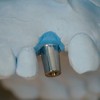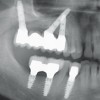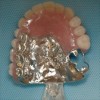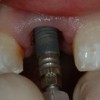The most natural appearance of anterior teeth results when perfect symmetry and regularity of the arrangement are avoided. Tooth and denture base characterization are important to obtaining a natural and pleasing appearance for the patient. Thus, in addition to the relationship to ridges and lips, consideration must also be given to spacing, inclination, and rotation of individual teeth within the arch. This program illustrates some of the basic techniques and approaches used to create a natural and esthetically pleasing display of the anterior teeth that fits the anatomic and personality profiles of the patient.
Complete Dentures -Esthetics & Characterization — Course Transcript
- 1. 12. Esthetics and Characterization Eleni Roumanas DDS Division of Advanced Prosthodontics, Biomaterials and Hospital Dentistry UCLA School of Dentistry Giulo Preti MD University of Turin and Frank Lauciello DDS Ivoclar Vivadent This program of instruction is protected by copyright ©. No portion of this program of instruction may be reproduced, recorded or transferred by any means electronic, digital, photographic, mechanical etc., or by any information storage or retrieval system, without prior permission.
- 2. DENTURE ESTHETICS & CHARACTERIZATION
- 3. Tooth Characterization Denture Base Characterization Denture Esthetics
- 4. Denture esthetics demands artistic skill in addition to scientific knowledge The best method of developing skills is by observing natural teeth Gingival Contour Females-delicate Males-rugged Tooth Wear Denture Esthetics
- 5. Carefully evaluation existing dentures Patient’s perception of their appearance. Your perception of the esthetic needs of the patient.
- 6. With age -grind incisal edges -grind proximal contacts Masculine -angular outlines -sharp lateral contours -larger laterals and canines Feminine -rounder outlines -smooth lateral contours -smaller laterals and canines Lateral incisors “personality tooth” -females – labioversion -males – linguoversion Individualized Characterization
- 7. Characterization of Maxillary Anterior Teeth Lateral Rotations Diastema Incisal Wear labioversion linguoversion
- 8. Vertical overlap Horizontal overlap Antero-posterior inclination in proximal view 4. Inclination of long axes Mandibular Anterior Teeth: Arrangement Considerations
- 9. Characterization of Lower Anterior Teeth Crowding & rotations Diastemas Staining Incisal Wear
- 10. Proper lip support – The orbicularis oris and other facial musculature are supported by the alveolous and teeth. Loss of teeth and resorption of the alveolar ridge results in facial collapse. -You cannot remove wrinkles which are a part of the skin aging process. Lip Support
- 11. Before After Improper Lip Support
- 12. Loss of VDO results in a more exaggerated class III occlusion Before After Loss of Vertical Dimension
- 13. Immediate Dentures The patient’s few remaining teeth provide an excellent guide for selection of mold and shade.
- 14. Immediate Dentures These immediate denture restore the natural appearance of the patient’s teeth as well as the gingival tissues.
- 15. Characterization
- 16. Anterior Tooth Characterization Central Lateral Canine Labial-palatal inclination Class 1 Perpendicular to ridge Class 2 Palatal inclination Class 3 Labial inclination Soft Bold Palatal inclination (neck out) Note: never upright or labial inclination labial (neck in) perpendicular Mesial-distal inclination none long axis of tooth inclined distally none Long axis of tooth inclined slightly toward the distal Note: never to the mesial Rotation Soft Bold Follow Distal arch flare Note: never mesial flare Mesial flare Distal flare Mesial flare naturally created by following the arch form Note: never distal flare Length Same length as wax rim 1-2mm less than phonetic rim same length as phonetic rim Same length as rim
- 17. Anterior Tooth Characterization Soft Bold Central Labial-palatal inclination Class 1 Perpendicular to ridge Class 2 Palatal inclination Class 3 Labial inclination Mesial-distal inclination none Rotation Soft Bold Follow Distal arch flare Note: never mesial flare Length Same length as wax rim
- 18. Class 1 7mm Central incisors perpendicular to the ridge Centrals: Labial-palatal Inclination
- 19. Class 2 7mm Central incisors slightly palatally inclined Centrals: Labial-palatal Inclination
- 20. Class 3 7mm Central incisors slightly labially inclined Centrals: Labial-palatal Inclination
- 21. NO TILTING OF CENTRALS. Esthetically Unacceptable To Tilt Maxillary Centrals Mesial Or Distal. Centrals: Mesial-Distal Inclination
- 22. Maxillary Centrals: Rotation Basic Set Up- The centrals follow the curve of the arch, gives a soft look to the set up.
- 23. Distal flare- Creates a highlight on the center of the tooth, thereby giving boldness to a set up. Maxillary Centrals: Rotation
- 24. Mesial flare- Mesial flare is esthetically unacceptable for centrals. Maxillary Centrals: Rotation
- 25. DEFLECTION neck out REFLECTION neck in Maxillary Centrals: Neck Position Unacceptable characterization since it will make one central look light and other will look dark.
- 26. Be careful, they don’t work for every patient. Diastemas
- 27. Anterior Tooth Characterization Soft Bold Lateral Labial-palatal inclination Soft Bold labial (neck in) perpendicular Mesial-distal inclination long axis of tooth inclined distally none Rotation Mesial flare Distal flare Length 1-2mm less than phonetic rim same length as phonetic rim
- 28. Perpendicular Neck in Maxillary Laterals: Labial-palatal Inclination – Neck tucked in toward the palatal is considered a soft characterization -Neck perpendicular to the palatal is a bold characterization
- 29. Distal Inclination Maxillary Laterals: Mesial-distal Inclination – Distal inclination of the long axis of the lateral is considered soft -Mesial inclination is considered not acceptable
- 30. Mesial flare (Mesioversion) Maxillary Laterals: Rotation – Considered a soft characteristics -Mesial flare of the lateral incisors is a characteristic most commonly seen in females, although it may occasionally be seen in natural male dentition.
- 31. Mesial Flair-Soft Effect Maxillary Laterals: Rotation
- 32. Distal flare Maxillary Laterals: Rotation -Considered a bold characteristic
- 33. Distal Flair-Bold Effect Maxillary Laterals: Rotation
- 34. Anterior Tooth Characterization Canine Labial-palatal inclination Palatal inclination (neck out) Note: never upright or labial inclination Mesial-distal inclination Long axis of tooth inclined slightly toward the distal Note: never to the mesial Rotation Mesial flare naturally created by following the arch form Note: never distal flare Length Same length as rim
- 35. Maxillary Canines: Labial-palatal Inclination Palatal inclination (neck out) – The facial surface of the tooth should never be upright or labialy inclined -The neck of the canine is out to create the curvature of the arch
- 36. Maxillary Canines: Mesial-distal Inclination perpendicular 15 ° Distal Inclination – The long axis of the canine is inclined slightly toward the distal Note: never to the mesial
- 37. Canine Rotation-Mesial flare – Mesial flare is naturally created by following the arch form
- 38. Canine Rotation-Distal flare -Distal flare is not considered an acceptable characteristic and is not recommended in denture characterization.
- 39. Festooning: Denture Base Anatomy – The gingival heights of the various teeth in the arch vary and should never be waxed straight across. This a common mistake made in denture festooning. -The lateral is always shorter than the canine or central. -The canine is always longer then the premolar.
- 40. gold amalgam Composite staining Tooth Characterization
- 41. Tooth Characterization-Staining – Staining kits may be used to further characterize denture teeth and make them more age appropriate. The most common areas to be stained are incisal edges, craze lines, interproximal contacts and the roots at the gingival level.
- 42. Gingival Characterization – Acrylic of various shades can be used to mimic the patients gingival coloration. -These colors are layered into the flask prior to packing. -Some discoloration/yellowing of the base occurs as the denture base ages .
- 43. Gingival staining Gingival Characterization
- 44. Gingival Characterization Gingival staining
- 45. LAB PRESCRIPTION Patient demographics Sex Personality Age Photos Pre-extraction casts Existing dentures – Providing the laboratory with these specific patient demographics allows them to fabricate a denture that is more consistant with the patients age, sex and personality.
- 46. Lab Communication – An excellent means of communicating esthetics to the patient and the lab is with these anterior denture simulation models. They can be fabricated with various tooth molds, shades and characterizations. Placed under the patients lip they are very useful in helping determine the most appropriate look for that patient.
- 47. Smile!


 Cement Retention vs Screw Retention
Cement Retention vs Screw Retention
 Restoration of Posterior Quadrants and Treatment Planning
Restoration of Posterior Quadrants and Treatment Planning
 Implants and RPDs
Implants and RPDs
 Single Tooth Defects in Posterior Quadrants
Single Tooth Defects in Posterior Quadrants
